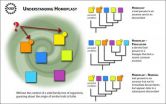(Press-News.org) How severe can climate change become in a warming world?
Worse than anything we've seen in written history, according to results of a study appearing this week in the journal Science.
An international team of scientists led by Curt Stager of Paul Smith's College, New York, has compiled four dozen paleoclimate records from sediment cores in Lake Tanganyika and other locations in Africa.
The records show that one of the most widespread and intense droughts of the last 50,000 years or more struck Africa and Southern Asia 17,000 to 16,000 years ago.
Between 18,000 and 15,000 years ago, large amounts of ice and meltwater entered the North Atlantic Ocean, causing regional cooling but also major drought in the tropics, says Paul Filmer, program director in the National Science Foundation's (NSF) Division of Earth Sciences, which funded the research along with NSF's Division of Atmospheric and Geospace Sciences and its Division of Ocean Sciences.
"The height of this time period coincided with one of the most extreme megadroughts of the last 50,000 years in the Afro-Asian monsoon region with potentially serious consequences for the Paleolithic humans that lived there at the time," says Filmer.
The "H1 megadrought," as it's known, was one of the most severe climate trials ever faced by anatomically modern humans.
Africa's Lake Victoria, now the world's largest tropical lake, dried out, as did Lake Tana in Ethiopia, and Lake Van in Turkey.
The Nile, Congo and other major rivers shriveled, and Asian summer monsoons weakened or failed from China to the Mediterranean, meaning the monsoon season carried little or no rainwater.
What caused the megadrought remains a mystery, but its timing suggests a link to Heinrich Event 1 (or "H1"), a massive surge of icebergs and meltwater into the North Atlantic at the close of the last ice age.
Previous studies had implicated southward drift of the tropical rain belt as a localized cause, but the broad geographic coverage in this study paints a more nuanced picture.
"If southward drift were the only cause," says Stager, lead author of the Science paper, "we'd have found evidence of wetting farther south. But the megadrought hit equatorial and southeastern Africa as well, so the rain belt didn't just move--it also weakened."
Climate models have yet to simulate the full scope of the event.
The lack of a complete explanation opens the question of whether an extreme megadrought could strike again as the world warms and de-ices further.
"There's much less ice left to collapse into the North Atlantic now," Stager says, "so I'd be surprised if it could all happen again--at least on such a huge scale."
Given what such a catastrophic megadrought could do to today's most densely populated regions of the globe, Stager hopes he's right.
INFORMATION:
Stager also holds an adjunct position at the Climate Change Institute, University of Maine, Orono.
Co-authors of the paper are David Ryves of Loughborough University in the United Kingdom; Brian Chase of the Institut des Sciences de l'Evolution de Montpellier in France and the Department of Archaeology, University of Bergen, Norway; and Francesco Pausata of the Geophysical Institute, University of Bergen, Norway.
Ancient catastrophic drought leads to question: How severe can climate change become?
Extreme megadrought in Afro-Asian region likely had consequences for Paleolithic cultures
2011-02-28
ELSE PRESS RELEASES FROM THIS DATE:
MIT scientists say ocean currents cause microbes to filter light
2011-02-28
Cambridge, MA- Adding particles to liquids to make currents visible is a common practice in the study of fluid mechanics. The approach was adopted and perfected by artist Paul Matisse in sculptures he calls Kalliroscopes. Matisse's glass-enclosed liquid sculptures contain an object whose movement through the liquid creates whorls that can be seen only because elongated particles trailing the object align with the direction of the current; light reflects off the particles, making the current visible to the viewer.
Researchers at MIT recently demonstrated that this same ...
Homoplasy: A good thread to pull to understand the evolutionary ball of yarn
2011-02-28
With the genetics of so many organisms that have different traits yet to study, and with the techniques for gathering full sets of genetic information from organisms rapidly evolving, the "forest" of evolution can be easily lost to the "trees" of each individual case and detail.
A review paper published this week in Science by David Wake, Marvalee Wake and Chelsea Specht, all currently National Science Foundation grantees, suggests that studying examples of homoplasy can help scientists analyze the overwhelming deluge of genetic data and information that is currently ...
A North American first at the Montreal Heart Institute could help treat thousands of Canadians
2011-02-28
Montreal, February 24, 2011 – The interventional cardiology team at the Montreal Heart Institute (MHI) recently began patient enrolment for a new device, the Neovasc ReducerTM, designed to treat patients suffering from refractory angina. The treatment method is a first in North America and is being conducted as part of an international study, the COSIRA trial. This innovative treatment is promising for thousands of Canadians disabled by refractory angina and who lack alternatives for relieving their symptoms and improving their quality of life.
Developed in Canada by ...
Strong link found between victimization, substance abuse
2011-02-28
A strong link between victimization experiences and substance abuse has been discovered by researchers at the University of Illinois at Chicago.
The correlation is especially prevalent among gays, lesbians and bisexuals -- more so than in heterosexuals, says Tonda Hughes, professor and interim head of health systems science in the UIC College of Nursing. Hughes is lead author of the study, published in the journal Addiction.
Researchers compared victimization experiences of unwanted sexual activity, neglect, physical violence, and assault with a weapon, across four ...
ONR's TechSolutions creating green ideas that light up ships and submarines
2011-02-28
ARLINGTON, Va. - One Sailor's request to replace humming fluorescent bulbs with a quiet alternative inspired the Office of Naval Research (ONR) to create the Solid State Lighting (SSL) project, currently being evaluated aboard several ships and submarines across the U.S. Navy.
A product of ONR's TechSolutions program, SSL is one of several rapid-response technologies created using recommendations and suggestions from Navy and Marine Corps personnel. (Watch TechSolutions products in action via YouTube.)
The SSL project introduced the energy-saving, nonhazardous LED ...
Making the 'irrelevant' relevant to understand memory and aging
2011-02-28
Age alters memory. But in what ways, and why? These questions comprise a vast puzzle for neurologists and psychologists. A new study looked at one puzzle piece: how older and younger adults encode and recall distracting, or irrelevant, information. The results, published in Psychological Science, a journal of the Association of Psychological Science, can help scientists better understand memory and aging.
"Our world contains so much information; we don't always know which is relevant and which is irrelevant," said Nigel Gopie, who cowrote the study with Fergus I.M. Craik ...
Missing sugar molecule raises diabetes risk in humans
2011-02-28
Researchers at the University of California, San Diego School of Medicine and Rady Children’s Hospital-San Diego say an evolutionary gene mutation that occurred in humans millions of years ago and our subsequent inability to produce a specific kind of sialic acid molecule appears to make people more vulnerable to developing type 2 diabetes, especially if they’re overweight.
The findings are published in the Feb. 24 online edition of The FASEB Journal, a publication of the Federation of American Societies of Experimental Biology.
Corresponding study author, Jane ...
Examining climate change effects on wheat
2011-02-28
Wheat growers in the Southwest have a better idea about how to adjust to climate change in the decades ahead, thanks to U.S. Department of Agriculture (USDA) scientists in Arizona.
Researchers with the USDA's Agricultural Research Service (ARS) installed infrared heaters in experimental wheat fields at the agency's Arid-Land Agricultural Research Center in Maricopa, Ariz., to simulate growing conditions expected by 2050. ARS is USDA's principal intramural scientific research agency, and this research supports the USDA priority of responding to climate change.
Wheat ...
Rituximab and fludarabine produce long-term remissions in CLL
2011-02-28
COLUMBUS, Ohio – New research shows that a less-toxic combination of a targeted immune-based drug and a chemotherapy drug can produce long-term remissions in some chronic lymphocytic leukemia patients. And it does so without increasing the risk of later therapy-related myelodysplastic syndrome and acute myeloid leukemia, which can often occur with a three-drug combination used to treat these patients.
The multi-institutional study, led by researchers at the Ohio State University Comprehensive Cancer Center – Arthur G. James Cancer Hospital and Richard J. Solove Research ...
Genetically modified fungi kill malaria-causing parasites in mosquitoes
2011-02-28
Spraying malaria-transmitting mosquitoes with a genetically modified fungus can kill the malaria parasite without harming the mosquito, potentially reducing malaria transmission to humans, according to a new study published in the journal Science. Funded by the National Institute of Allergy and Infectious Diseases (NIAID), part of the National Institutes of Health, the study was led by Raymond J. St. Leger, Ph.D., of the University of Maryland, College Park.
An estimated 225 million malaria cases occur worldwide annually, resulting in about 781,000 deaths each year, ...
LAST 30 PRESS RELEASES:
The Ceramic Society of Japan’s Oxoate Ceramics Research Association launches new international book project
Heart-brain connection: international study reveals the role of the vagus nerve in keeping the heart young
Researchers identify Rb1 as a predictive biomarker for a new therapeutic strategy in some breast cancers
Survey reveals ethical gaps slowing AI adoption in pediatric surgery
Stimulant ADHD medications work differently than thought
AI overestimates how smart people are, according to HSE economists
HSE researchers create genome-wide map of quadruplexes
Scientists boost cell "powerhouses" to burn more calories
Automatic label checking: The missing step in making reliable medical AI
Low daily alcohol intake linked to 50% heightened mouth cancer risk in India
American Meteorological Society announces Rick Spinrad as 2026 President-Elect
Biomass-based carbon capture spotlighted in newly released global climate webinar recording
Illuminating invisible nano pollutants: advanced bioimaging tracks the full journey of emerging nanoscale contaminants in living systems
How does age affect recovery from spinal cord injury?
Novel AI tool offers prognosis for patients with head and neck cancer
Fathers’ microplastic exposure tied to their children’s metabolic problems
Research validates laboratory model for studying high-grade serous ovarian cancer
SIR 2026 delivers transformative breakthroughs in minimally invasive medicine to improve patient care
Stem Cell Reports most downloaded papers of 2025 highlight the breadth and impact of stem cell research
Oxford-led study estimates NHS spends around 3% of its primary and secondary care budget on the health impacts of heat and cold in England
A researcher’s long quest leads to a smart composite breakthrough
Urban wild bees act as “microbial sensors” of city health.
New study finds where you live affects recovery after a hip fracture
Forecasting the impact of fully automated vehicle adoption on US road traffic injuries
Alcohol-related hospitalizations from 2016 to 2022
Semaglutide and hospitalizations in patients with obesity and established cardiovascular disease
Researchers ‘listen in’ to embryo-mother interactions during implantation using a culture system replicating the womb lining
How changing your diet could help save the world
How to make AI truly scalable and reliable for real-time traffic assignment?
Beyond fragmented markets: A new framework for efficient and stable ride-pooling
[Press-News.org] Ancient catastrophic drought leads to question: How severe can climate change become?Extreme megadrought in Afro-Asian region likely had consequences for Paleolithic cultures


